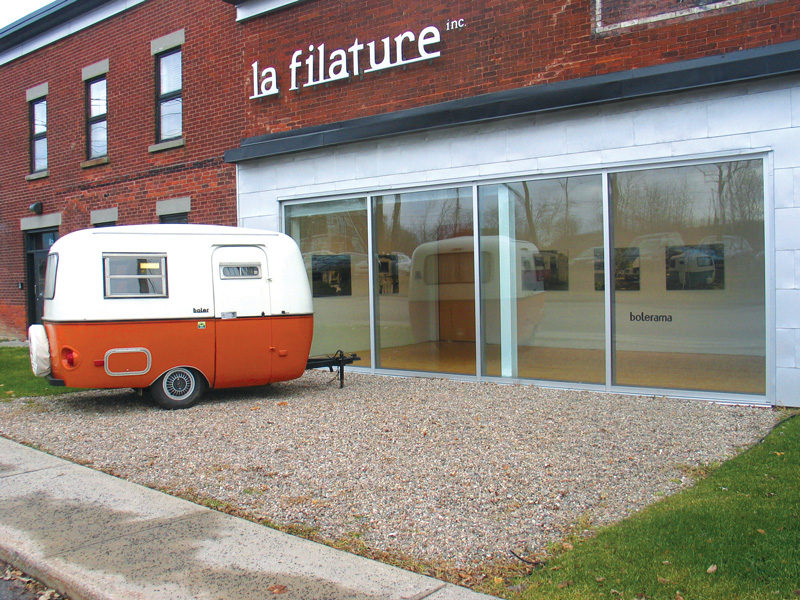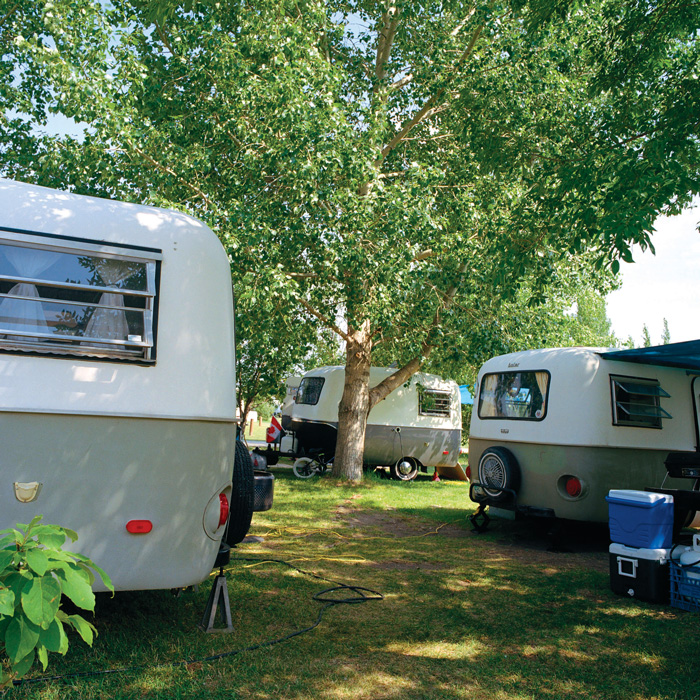[Spring/Summer 2011]
Lise Beaudry
Bolerama
Axenéo7, Gatineau
November 3 to December 5, 2010
An egg-shaped camping trailer nuzzles up to the large plate-glass windows of Galerie Axenéo7. It is faced by a series of photos of its relatives, Boler camping trailers all of which share the same compact, rounded form but vary endlessly in their fittings and colours. The light-weight fibreglass trailer was first designed in Winnipeg by Ray Olecko, and was produced in various places in Canada from 1968 to 1988.1 Lise Beaudry, a young photographer based in Toronto, is the proud owner of this particular Boler, and the artist behind the exhibition, “Bolerama” (the name Boler owners give to their yearly camping meets). Beaudry grew up in Earlton, a small Ontario town where a thirteen-feet Boler was manufactured from 1972 to 1979. Fascinated by how people from different walks of life bond around an object that they all love, the artist packed her analogue Hasselblad camera into her own Boler and went to hang out with fellow owners at four different Boleramas. The materiality of analogue photography matches Beaudry’s focus on tangibility well, while the slowness of this photographic process mirrors the slowness of her documentary method, which involved becoming an active participant of the community she photographed.
Other than a few figures in the background, there are no people in Beaudry’s “Bolerama,” but the carefully restored camping “capsules,” which have been out of production for more than twenty years, imply a human presence. A streak of nostalgia runs through the exhibition, as it does through some of Beaudry’s previous work, including a series of an abandoned drive-in-theatre and a series of ice-fishing huts. Those photographs of hand-built constructions set in a rural landscape share a sense of pastness with the Bolers. The artist ignores the hurried rush and noise of contemporary city life and the virtual, intangible communities of Facebook and Twitter in order to foreground a more hands-on, perhaps more vital, community that is created around a specific object.
Paradoxically, however, it is precisely technology-based social networking that facilitates the emergence of communities sharing a passion for rare, odd, or obsolete objects such as the Boler. An audio component of the exhibition highlights the mix of intangible media with the real-life connections between people and things. Sitting at the little fold-out table in Beaudry’s Boler outside the gallery, visitors can hear stories by and interviews with participants, as well as ambient campground sounds, coming from a system of small, rounded speakers that are similar to the aesthetic of the Boler.
Beaudry’s nostalgia is bound up with the not-so-ancient past of modernity. Boler communities spring from a yearning not for pre-modern times – the Group of Seven’s bushwhacking mentality – but for certain hands-on technologies that showed such promise in modernism. Fibre-reinforced polymer, invented in the 1930s, was one such technique. Its light weight and relative ease of application revolutionized outdoor sculpture and design throughout the following decennia. It was a cheap alternative to bronze, stone, and wood, and it enabled large structures to be created in forms and shapes previously unimagined.2 Aside from the health risks inherent to producing it, fibreglass has disappointed in present times due to the deadening commercialization that comes with its democratization. Still, for every city-full of giant moose, tulips, or cows, there are artists such as David Altmejd and Joep van Lieshout, who invest the medium with a creative vengeance.3 Beaudry has turned her camera to a more mainstream creative community. The simple fibreglass fabrication of the Boler appears to lend itself well to creative tinkering with the many surviving originals. Holding on to the endearing shape of the rounded trailer, owners continue to preserve these objects, recycling, repairing, and redecorating them by hand.
The egg-on-wheels Boler has a womb-like feel, inviting its inhabitants to retreat from the outside world and curl up inside. Some of Beaudry’s photographs, such as the silky-soft image of the tussled sheets (Unmade Bed, 2006), allude to such escapist security. But the trailer’s secluded inside, where all of our private needs can be met, has windows to the outside, windows that connect to the “others” we need to fulfil our social needs. Outside, the photographs show the paths of Boler owners crossing and converging in clusters of camping chairs and barbecue set-ups. The accoutrements and decorations of the basic Boler create not only a sense of individual identity for the owners, but a sense of community – a community that begins with much planning, discussion, trading, mutual admiration, and advice in the blogosphere, but finally materializes on the campground, at the Bolerama.
2 “The Poor Man’s Composite,” http://microship.com/resources/ cardboard-core-composites.html, retrieved 20 December 2010.
3 http://www.andrearosengallery.com/artists/david-altmejd and http://www.designboom.com/eng/interview/ vanlieshout.html, retrieved 20 December 2010.
Petra Halkes is an artist and writer living in Ottawa.


